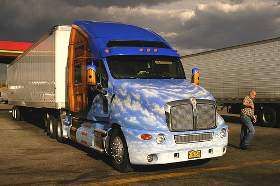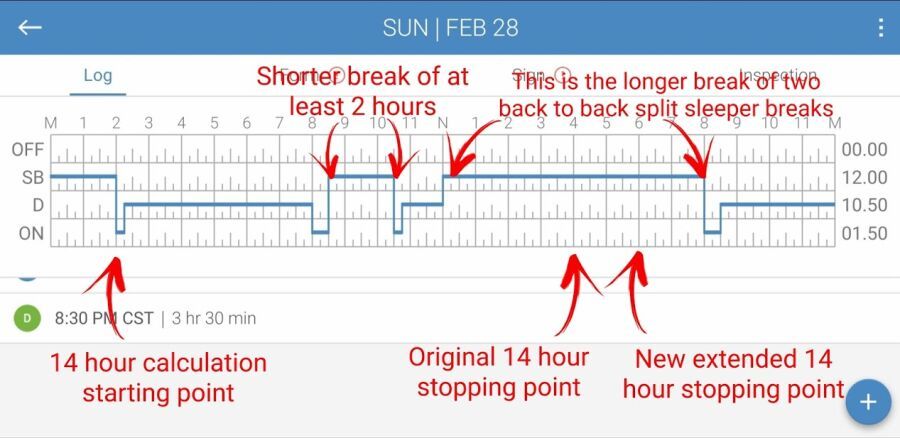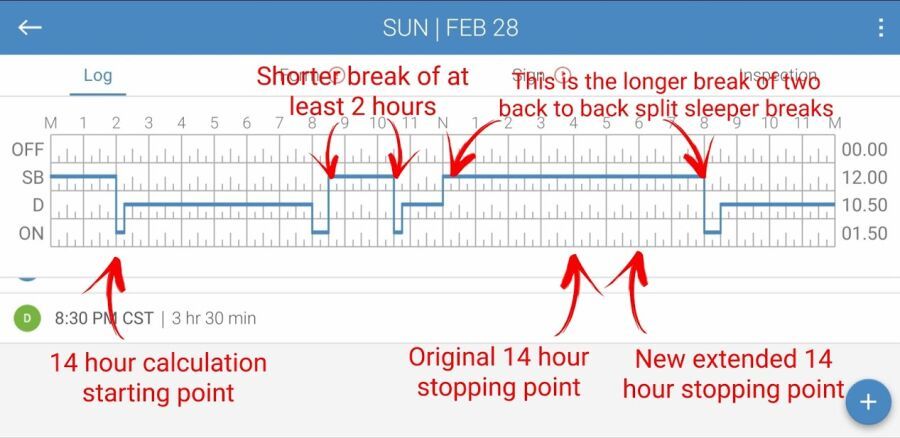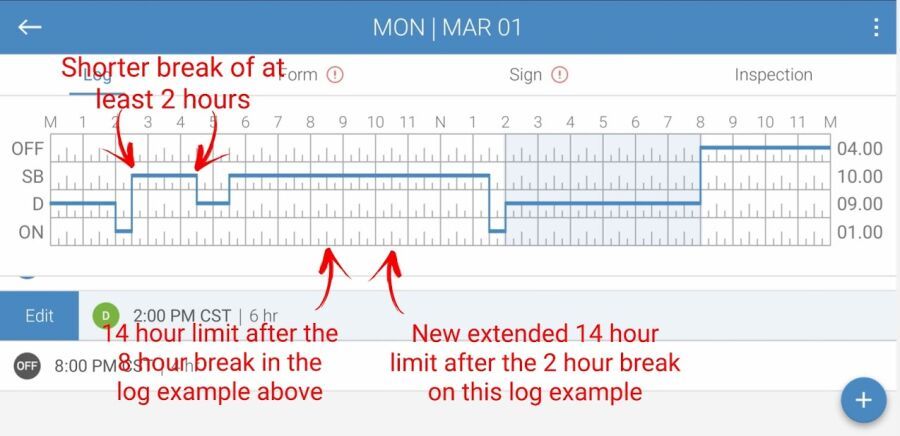HOS Rules; New 8/2 Or 7/3 Split
Topic 30343 | Page 3
How does the 7/3 or 8/2 work when passing the midnight recap? Couple days ago I drove 8 hours and 40 minutes , so I had 2 hours and 20 left on my clock. I'm 2 hours from delivery and figured I'd get the 3 hours on the unload. After 7 hours in sleeper I've got 5:30 in hours. It's got something to do with the midnight recap even tho my recap was 9:5.

Hi donna,
There's only two ways (unless i'm wrong) you will get 5:30 back after 7 hours in sleeper as long as your not driving on your 14. Conventionally, you take a 10 hour break to reset your clocks, drive 5:30, take a 7 hour break in sleeper and have 5:30 left to drive.
Or, you drove less than 5:30, took a 3 hour break, then drove 5:30, then took a 7 hour break in sleeper. After the 7 hour break in sleeper you'd have 5:30 left to drive.
You'll need to look at what your last break was before your 7 hour sleeper break.
How does the 7/3 or 8/2 work when passing the midnight recap?
Great question!
When using a split you get back the time you used prior to your first break. That is added to your remaining time, but if you passed midnight during that second break, and are running on re-caps, you also need to add in those hours you get from the re-caps.
Just to add to all the confusion, and hopefully clarify this for a few of you, here is an example from the revised High Road Training program. The log example uses back to back split sleeper breaks. For this discussion, I only talk about the one shown on the log example. This example assumes the driver is not running on recaps and started his day with full 11 and 14 hour clocks.

Our driver started his day at 0200 (2:00 a.m.) He performed a 15-minute pre-trip inspection , and then proceeded to drive at 2:15 a.m. He drove 5 hours and 45 minutes, arriving at his consignee at 0800. His appointment was for 0830, so he is 30 minutes early. He backs into the door they’ve assigned him and logs 30 minutes of on-duty time. Then he decides to switch his logs to sleeper berth and take a little rest while he is waiting for them to unload him. He gets a full 2 hours of rest before he has to log back on duty to get his paperwork signed and check out with security.
Now he drives for 1 hour and 15 minutes to his next shipper’s location. Unfortunately they are not ready for him, but they will allow him to park on their property until they can get his load ready. He parks and logs himself onto the sleeper berth line. It’s a good thing he does too. They take a lot of time to get his trailer loaded. Finally he is loaded at 2000 (8:00 p.m.). He logs himself back on duty, checks his load and gets his paperwork before starting his drive. Now he needs to know how many hours he has to drive.
Here is how that works. He got the first half of his split sleeper done when he took the 2-hour break at his consignee. His original 14-hour clock was to expire at 1600 (4:00 p.m.) because he started his day at 0200 (2:00 a.m.). The rules say that neither break counts against the 14-hour clock, so that changes the time his 14-hour limit runs out. He took 2 hours off, so that extended his 14-hour limit to 1800 (6:00 p.m.).
Then he took the second half of the split sleeper while waiting to be loaded at his shipper. That gives him a total of 10 hours off duty when he combines those two breaks. This allows him liberty to drive again, but he needs to know how many hours he can use now. Since the 8-hour break he took doesn’t count against his 14-hour clock, we need to know how many hours were left on his 14-hour clock when he started that 8-hour break. That’s simple - he started it at noon. We know that he had 6 hours left on his 14-hour clock at noon. His first break had extended his 14-hour clock to 1800 (6:00 p.m.). Therefore he will still have 6 hours left after the 8-hour break. That 8-hour break does not count against his 14-hour clock. His new 14-hour clock expires at 0200 (2:00 a.m.). But wait, there’s more!
We need to know how many driving hours he has now. That is what his 11-hour clock represents. If you look at his logs above you will see that he started his day at 0200. He has driven a total of 7 hours before starting his second half of his split-sleeper berth. That is what he has used from his 11-hour clock. Then you can see that he has used up 8 hours of his 14-hour clock. That is the combined total of on duty and driving time. Those hours are used up. What remains will be used in our new calculation. Remember the 2-hour break did not count against the 14-hour clock. That moved his 14-hour clock from expiring at 1600 (4:00 p.m.) to expiring at 1800 (6:00 p.m.). When he began his second break he had 6 hours remaining on his 14-hour clock and 4 hours remaining on his 11-hour clock. After he completes that second break there is a new calculation.
We now must add in the time he gets back for taking a total of 10 hours with his combined two breaks. He gets back the total of the time he used prior to his first break. Can you remember what he did? He started at 0200 (2:00 a.m.). We come up with a total of 45 minutes on duty when we combine his pre-trip inspection and the time he used while checking in and finding his door at his consignee. He also had a total of 5 hours and 45 minutes drive time. By adding his driving time and his on-duty time together, we come up with a total of 6.5 hours to be added to his 14-hour clock. After his second break he will have 6.5 hours to be added on his 14-hour clock and 5 hours and 45 minutes added on to what remains of his 11-hour clock. The 5 hours and 45 minutes of driving time will be added to his remaining 4 hours, giving him a new total of 9.75 hours for his 11-hour clock. The 6.5 hours from the start of his day to the point where he started his first break, is added to the 6 hours he had remaining. Giving him 12.5 hours on his 14-hour clock, which means his new 14-hour limit expires at 8:30 a.m.
Pre-trip Inspection:
A pre-trip inspection is a thorough inspection of the truck completed before driving for the first time each day.
Federal and state laws require that drivers inspect their vehicles. Federal and state inspectors also may inspect your vehicles. If they judge a vehicle to be unsafe, they will put it “out of service” until it is repaired.
Consignee:
The customer the freight is being delivered to. Also referred to as "the receiver". The shipper is the customer that is shipping the goods, the consignee is the customer receiving the goods.
Shipper:
The customer who is shipping the freight. This is where the driver will pick up a load and then deliver it to the receiver or consignee.
Sleeper Berth:
The portion of the tractor behind the seats which acts as the "living space" for the driver. It generally contains a bed (or bunk beds), cabinets, lights, temperature control knobs, and 12 volt plugs for power.
HOS:
Hours Of Service
HOS refers to the logbook hours of service regulations.Well, I wrote this long winded reply, lol, but it wouldn't submit. Could be my internet connection, I've been having trouble with that. Aaa, it wasn't that long, short really. Basically, just thanks (on my own behalf) for all of the replies. Old Schools above info. was really useful. Oh, haha, and I commented that all of this reminds me of word problems in Math, I really hated those.
BMI:
Body mass index (BMI)
BMI is a formula that uses weight and height to estimate body fat. For most people, BMI provides a reasonable estimate of body fat. The BMI's biggest weakness is that it doesn't consider individual factors such as bone or muscle mass. BMI may:
- Underestimate body fat for older adults or other people with low muscle mass
- Overestimate body fat for people who are very muscular and physically fit
It's quite common, especially for men, to fall into the "overweight" category if you happen to be stronger than average. If you're pretty strong but in good shape then pay no attention.
HOS:
Hours Of Service
HOS refers to the logbook hours of service regulations.Just a quick 'bump.' Good start, Rob D. . . confusing but ... illustrative and REAL!
Thought maybe KID or another one of the new(er) peeps might want to re read. Bunch of y'all going to CFI etc, soonish!
D'train, you also... bookmark this stuff!! Priceless. O/S's chart..save that w/the OTHERS ye'got~!!
Thank you, guys n gals for this thread..... it's in MY cache~!! Excellent illustration, O/S . . .
~ Anne ~
Thanks for all the valuable information, could they have made this anymore confusing?
My question is, can I do two splits in a row? 8/2 split my previous shift and another split my next work shift?
can I do two splits in a row? 8/2 split my previous shift and another split my next work shift?
Yes you can. Let me try to explain...
There are a few things you have to keep in mind when using the split-sleeper-berth rule. Here is a little review:
- You must meet the two minimum requirements. Those are: One break must be a minimum of 2 hours, and the other break must be a minimum of 7 hours.
- When you combine the two breaks they must equal a total of 10 hours.
- The longer of the two breaks must be logged in the sleeper berth.
- Neither break period counts against your 14-hour clock.
Okay let’s dig into an example or two to see if we can wrap our minds around this fascinating rule. Remember that you do not fully reset your 11 and 14-hour clocks with the split sleeper. You will reset specific times, and these examples are to help you understand how to calculate your hours when using the split-sleeper-berth rule.
This first example assumes the driver involved just finished a 10-hour break and has fully reset his 11 and 14-hour clocks. Here is an example of our first trucker’s logs.

Our driver started his day at 0200 (2:00 a.m.) He performed a 15-minute pre-trip inspection , and then proceeded to drive at 2:15 a.m. He drove 5 hours and 45 minutes, arriving at his consignee at 0800. His appointment was for 0830, so he is 30 minutes early. He backs into the door they’ve assigned him and logs 30 minutes of on-duty time. Then he decides to switch his logs to sleeper berth and take a little rest while he is waiting for them to unload him. He gets a full 2 hours of rest before he has to log back on duty to get his paperwork signed and check out with security.
Now he drives for 1 hour and 15 minutes to his next shipper’s location. Unfortunately they are not ready for him, but they will allow him to park on their property until they can get his load ready. He parks and logs himself onto the sleeper berth line. It’s a good thing he does too. They take a lot of time to get his trailer loaded. Finally he is loaded at 2000 (8:00 p.m.). He logs himself back on duty, checks his load and gets his paperwork before starting his drive. Now he needs to know how many hours he has to drive.
Here is how that works. He got the first half of his split sleeper done when he took the 2-hour break at his consignee. His original 14-hour clock was to expire at 1600 (4:00 p.m.) because he started his day at 0200 (2:00 a.m.). The rules say that neither break counts against the 14-hour clock, so that changes the time his 14-hour limit runs out. He took 2 hours off, so that extended his 14-hour limit to 1800 (6:00 p.m.).
Then he took the second half of the split sleeper while waiting to be loaded at his shipper. That gives him a total of 10 hours off duty when he combines those two breaks. This allows him liberty to drive again, but he needs to know how many hours he can use now. Since the 8-hour break he took doesn’t count against his 14-hour clock, we need to know how many hours were left on his 14-hour clock when he started that 8-hour break. That’s simple - he started it at noon. We know that he had 6 hours left on his 14-hour clock at noon. His first break had extended his 14-hour clock to 1800 (6:00 p.m.). Therefore he will still have 6 hours left after the 8-hour break. That 8-hour break does not count against his 14-hour clock. His new 14-hour clock expires at 0200 (2:00 a.m.). But wait, there’s more!
Continued...
Pre-trip Inspection:
A pre-trip inspection is a thorough inspection of the truck completed before driving for the first time each day.
Federal and state laws require that drivers inspect their vehicles. Federal and state inspectors also may inspect your vehicles. If they judge a vehicle to be unsafe, they will put it “out of service” until it is repaired.
Consignee:
The customer the freight is being delivered to. Also referred to as "the receiver". The shipper is the customer that is shipping the goods, the consignee is the customer receiving the goods.
Shipper:
The customer who is shipping the freight. This is where the driver will pick up a load and then deliver it to the receiver or consignee.
Sleeper Berth:
The portion of the tractor behind the seats which acts as the "living space" for the driver. It generally contains a bed (or bunk beds), cabinets, lights, temperature control knobs, and 12 volt plugs for power.
HOS:
Hours Of Service
HOS refers to the logbook hours of service regulations.We need to know how many driving hours he has now. That is what his 11-hour clock represents. If you look at his logs above you will see that he started his day at 0200. He has driven a total of 7 hours before starting his second half of his split-sleeper berth. That is what he has used from his 11-hour clock. Then you can see that he has used up 8 hours of his 14-hour clock. That is the combined total of on duty and driving time. Those hours are used up. What remains will be used in our new calculation. Remember the 2-hour break did not count against the 14-hour clock. That moved his 14-hour clock from expiring at 1600 (4:00 p.m.) to expiring at 1800 (6:00 p.m.). When he began his second break he had 6 hours remaining on his 14-hour clock and 4 hours remaining on his 11-hour clock. After he completes that second break there is a new calculation.
We now must add in the time he gets back for taking a total of 10 hours with his combined two breaks. He gets back the total of the time he used prior to his first break. Can you remember what he did? He started at 0200 (2:00 a.m.). We come up with a total of 45 minutes on duty when we combine his pre-trip inspection and the time he used while checking in and finding his door at his consignee. He also had a total of 5 hours and 45 minutes drive time. By adding his driving time and his on-duty time together, we come up with a total of 6.5 hours to be added to his 14-hour clock. After his second break he will have 6.5 hours to be added on his 14-hour clock and 5 hours and 45 minutes added on to what remains of his 11-hour clock. The 5 hours and 45 minutes of driving time will be added to his remaining 4 hours, giving him a new total of 9.75 hours for his 11-hour clock. The 6.5 hours from the start of his day to the point where he started his first break, is added to the 6 hours he had remaining. Giving him 12.5 hours on his 14-hour clock, which means his new 14-hour limit expires at 8:30 a.m.
Let’s use this same driver’s logs for our second example. We will begin right where we left off. After finishing 8 hours in the sleeper, he began driving after taking 30 minutes to check his trailer, and adding a couple of load bars to his new load. He drives 300 miles to his next destination. It takes him every bit of 5 hours and 30 minutes to get there, but he arrives just ahead of his 0230 appointment. He logs himself on duty for 30 minutes while he checks in and gets backed into position. Then he logs himself into the sleeper while he rests and waits for them to unload his trailer. 2 hours later they have emptied him out. He now has 2 hours logged in the sleeper. He can pair that 2 hours with his previous 8 hours in the sleeper and hit the road again. Here’s a look at his next day’s log.

How can he calculate his hours at this point and know what he has available to him? Do you remember how we did it in our previous example? He gets back the hours that were used prior to his first break. So now this driver gets back the hours before the 8-hour break he took at the shipper. It’s not much in this scenario, but we used it to show how you can do these splits back to back. There is no limit to how many times you can pair these things together back to back. In this case he will only get 1.5 on his 14-hour clock, and 1 hour and 15 minutes on his 11-hour clock.
Let’s do the math. He drove for 5.5 hours and was on duty an additional 1 hour more than that. That leaves him with 4.25 hours on his 11-hour clock and 6 hours on his 14-hour clock. Now we have to add the hours before his first break to those totals. To calculate his 14-hour limit we will add the 1.5 hours prior to his first break to the remaining 6 hours, giving him a new total of 7.5 on his 14, and we must also add the 2 hours he was in the sleeper (remember, that time does not count against the 14). This gives him 9.5 hours on his 14, extending his limit to 1400 (2:00 p.m.). To calculate his 11-hour (or driving limit) we add the 1.25 driving hours, prior to the first break of this pair, to the remaining 4.25 hours and we find that he has 5.5 hours on his new 11-hour clock.
If you aren’t clear on how we came up with that, then just remember that he gets back the hours used prior to his first break, and time spent in the sleeper, when pairing two breaks together for a split, does not count against your 14-hour clock. Now, if your head is spinning, just go back and work through it again. Repetition will help it become more clear. If you can get them, draw these scenarios out on paper logs. That will help you visualize what is happening.
Pre-trip Inspection:
A pre-trip inspection is a thorough inspection of the truck completed before driving for the first time each day.
Federal and state laws require that drivers inspect their vehicles. Federal and state inspectors also may inspect your vehicles. If they judge a vehicle to be unsafe, they will put it “out of service” until it is repaired.
Consignee:
The customer the freight is being delivered to. Also referred to as "the receiver". The shipper is the customer that is shipping the goods, the consignee is the customer receiving the goods.
Shipper:
The customer who is shipping the freight. This is where the driver will pick up a load and then deliver it to the receiver or consignee.
Sleeper Berth:
The portion of the tractor behind the seats which acts as the "living space" for the driver. It generally contains a bed (or bunk beds), cabinets, lights, temperature control knobs, and 12 volt plugs for power.
HOS:
Hours Of Service
HOS refers to the logbook hours of service regulations.There is something wrong with a rule that requires so much effort to understand. Also, in my eyes this rule benefits companies' productivity, but hurts drivers' quality of life.
New Reply:
New! Check out our help videos for a better understanding of our forum features

















Preview:
This topic has the following tags:
Advice For New Truck Drivers Becoming A Truck Driver DOT Hours Of Service Split Sleeper Berth Rule







 TT On Facebook
TT On Facebook
Bobcat, yours is a company policy put in place to conform to 2021 Illinois state labor laws requiring employers to provide a 30 minute meal break to any employees working beyond 8 hours in a shift. From a legal standpoint, there is nothing requiring you to take that break off-duty. FMCSA has clear guidance on this. However, you must still follow your company's policy, of course.
CSA:
Compliance, Safety, Accountability (CSA)
The CSA is a Federal Motor Carrier Safety Administration (FMCSA) initiative to improve large truck and bus safety and ultimately reduce crashes, injuries, and fatalities that are related to commercial motor vehicle
FMCSA:
Federal Motor Carrier Safety Administration
The FMCSA was established within the Department of Transportation on January 1, 2000. Their primary mission is to prevent commercial motor vehicle-related fatalities and injuries.
What Does The FMCSA Do?
Fm:
Dispatcher, Fleet Manager, Driver Manager
The primary person a driver communicates with at his/her company. A dispatcher can play many roles, depending on the company's structure. Dispatchers may assign freight, file requests for home time, relay messages between the driver and management, inform customer service of any delays, change appointment times, and report information to the load planners.